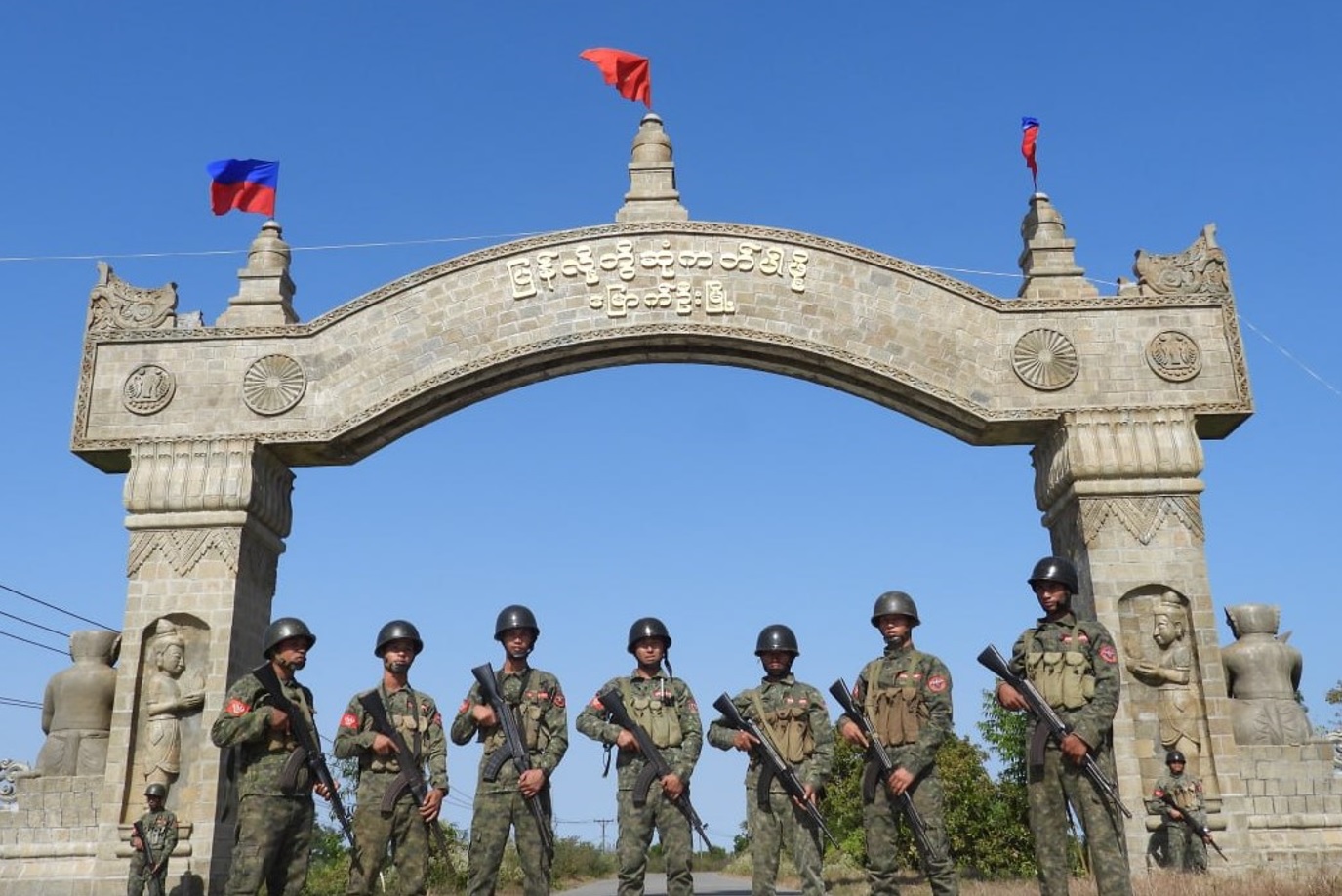It has been over two months since the Northern Alliance – which is made up of armed ethnic organisations, as well as the armed wing of the Burmese Communist Party – launched ‘Operation 1027’ in northern Shan State in Burma. Other resistance forces have also attacked junta bases in the states of Karenni, Rakhine, Chin, Karen, Sagaing Region and Bago Region. As events are unfolding rapidly in Burma, this article can only provide the latest verifiable information. However, all signs point towards one clear outcome: the end of General Min Aung Hliang’s government.
The Junta’s battered troops
Since 27 October when Operation 1027 was launched in northern Shan State by the Northern Alliance, the military regime has lost control of more than 300 military outposts and 20 towns across three states and two regions.
Significantly, the most important border trade hubs in Muse and Chin Shwe Haw – trade towns along China-Burma border in northern Shan State – also fell to the Northern Alliance forces, almost halting the trade with China on which Burma is economically dependent. In January, the alliance took over Lauk Kai/Old Street, the capital city of the ethnically Chinese Kokang self-administration zone, in Shan State.
Beyond northern Shan State, the resistance forces have seized the junta’s military outposts in Rakhine, Karenni and Karen states and now control several towns in Chin land and Sagaing Region. Adding insult to injury, Light Infantry Battalions 129 and 125 surrendered to the forces of the Northern Alliance en masse. This has exposed the lack of fighting spirit among the rank and file of the junta’s forces who are demoralised, realising that they gain nothing by sacrificing their own lives for this rotten regime. It is a well known fact that corruption is rampant in the ranks of the ruling military.
The biggest defeat for the junta so far has been the surrender to the MNDAA of Laukkai – the capital of northern Shan State’s Kokang Self-Administered Zone – despite the presence of several battalions in that region. Min Aung Hlaing’s regime responded to this failure by punishing the six brigadier generals in charge of those troops.
In retaliation, the junta has increasingly used such brutal measures as airstrikes and shelling, which have targeted schools, hospitals, villages and towns that have come under the control of the resistance forces.
“Even if you can militarily seize towns and villages in ethnic areas, your regions will never be peaceful. We will always carry out air raids using the sophisticated weapons we have,” the junta’s National Solidarity and Peace Negotiation Committee (NSPNC) secretary Lieutenant General Min Naing was quoted as saying in negotiations with the TNLA that subsequently broke down.
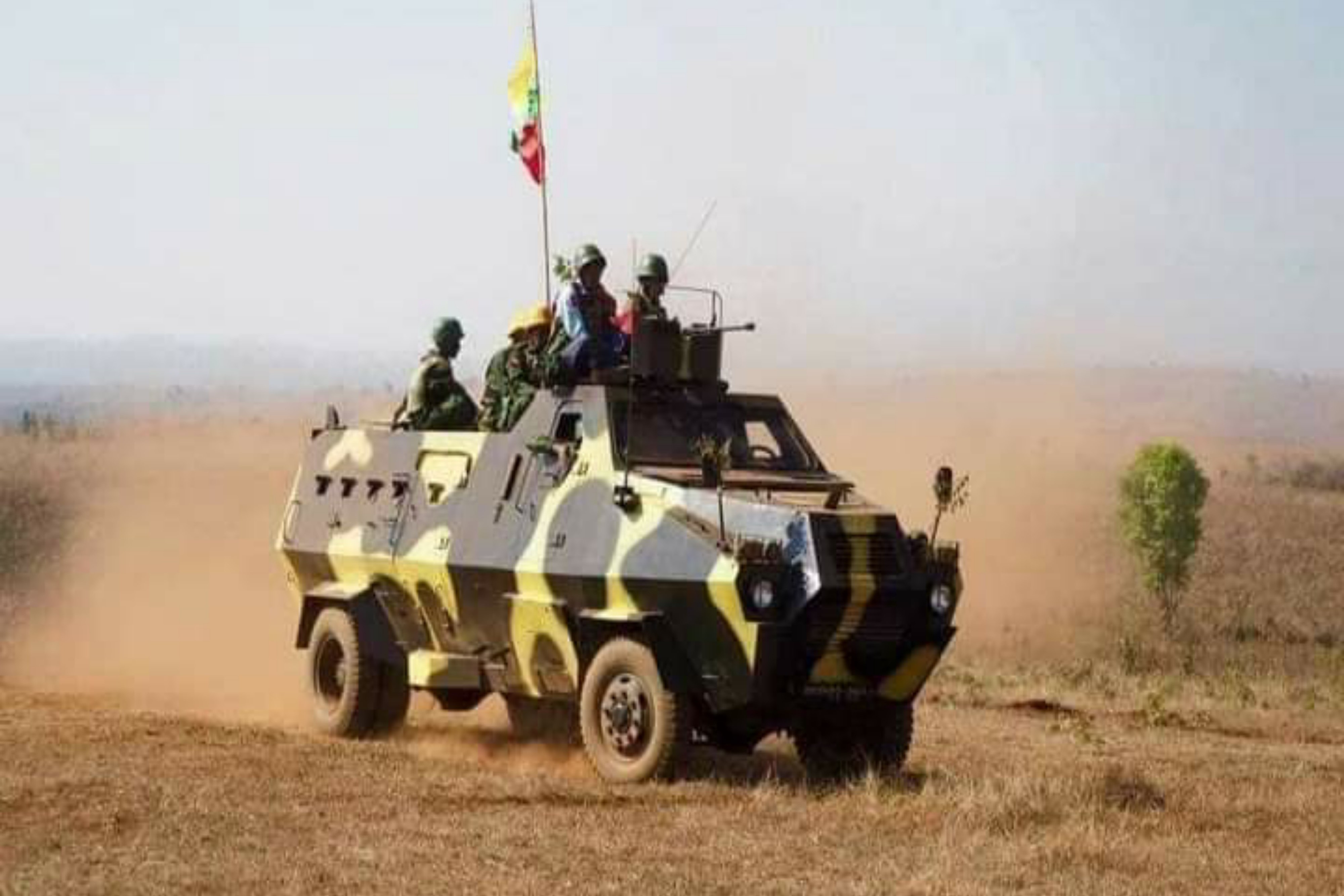 Facing attacks from all sides and significant losses, the junta’s troops appear to be exhausted and thinly stretched across the country / Image: public domain
Facing attacks from all sides and significant losses, the junta’s troops appear to be exhausted and thinly stretched across the country / Image: public domain
Facing attacks from all sides and significant losses, the junta’s troops appear to be exhausted and thinly stretched across the country. The coup regime has been unable to provide sufficient and timely military reinforcements. The use of indiscriminate shelling and air strikes show their desperation. Even this cruel method amounting to ‘war crimes’ has its limitations: the regime cannot afford sufficient jet fuel in the long run, and in the last month the ethnic armed groups have shown that they are capable of striking down the junta’s war planes.
As we explained in a previous article, the timing of this operation has fallen precisely at a time when China’s interests have come into conflict with those of Min Aung Hlaing’s regime. Min Aung Hlaing, the coup leader, has admitted to suffering defeats, and gave his ‘explanations’ at an emergency meeting of the National Defense and Security Council on 8 November. He explained that the junta’s bases in northern Shan State were being bombed mainly using Chinese-manufactured drones that can easily be bought on the market. In other words, the coup leader was trying to please Beijing by indirectly indicating that he thought China was not, in fact, providing material assistance to the resistance forces.
But, three weeks later, at the State Administration Council (SAC) meeting on 29 November, Min Aung Hlaing changed his tone. Via state media, he said that the Northern alliance forces had been using “military-grade drones with advanced technology using superior forces”. The junta’s chief also railed against “outside intervention” saying, “6,500 foreign drone experts had been involved” in these attacks on the military bases in northern Shan State along the border with China. Although he did not mention the foreign country in question, everyone knows who he is referring to when talking about “foreign intervention”.
It was no accident that in the third week of November, Bamar Buddhist ultranationalists staged anti-Chinese protests in front of the Chinese embassy and Yangon City Hall, without any interruption of police forces. Indeed, these rallies took place with their protection, a striking fact when we consider the junta’s killings conducted against peaceful protests of dissident youth.
But these tactics utterly failed. Even with state sponsorship, the hated military regime is proving unable to organise a sizable nationalist movement.
Min Aung Hlaing’s clique begs for China’s mediation
Against the backdrop of a series of defeats on the battlefield and catastrophic economic conditions, it did not take the junta long to understand the reality. The regime was compelled to beg for Beijing to broker peace talks with the Northern Alliance forces. According to The Irrawaddy, when the junta’s foreign minister, Than Swe, met with his Chinese counterpart Wang Yi in Beijing on 6 December, he delivered the message that the junta boss Min Aung Hlaing is ready to make concessions.
It is also clear that the Northern Alliance was forced to the negotiation table under the pressure of Beijing, the latter being eager for the situation to calm and for business to resume. But it is very much doubtful that the military regime is ready to give concessions to the alliance forces. The rebels will also be very suspicious of the junta’s manoeuvres. Amid the news of peace talks with “positive results”, armed clashes have been intensifying.
It is unlikely that China will directly intervene or openly provide massive material support to the rebel groups to oust the military regime. But Beijing, facing growing class struggle at home, is not going to throw its backing behind the Min Aung Hlaing clique, which has only exacerbated the instabilities along its borders.
Illusions in the tactic of armed struggle
Since the recent operation began, illusions in armed struggle have once again been strengthened. Both passive spectators and participants in it concluded that a chain of military victories would eventually overthrow the military dictatorship. In their view, this is what it means to ‘make a revolution’ to liberate the people under the rule of military dictatorship.
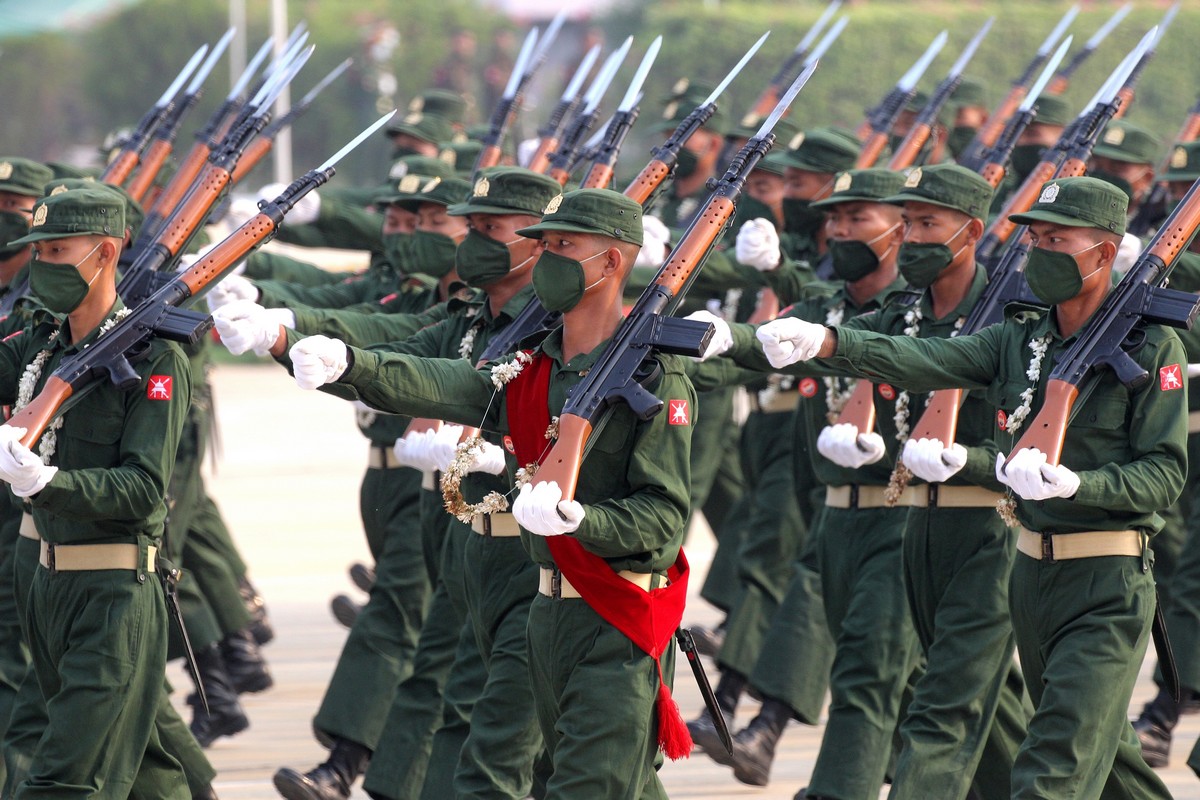 Without a revolutionary mass movement, military means alone cannot achieve revolutionary tasks / Image: Mil.ru, Wikimedia Commons
Without a revolutionary mass movement, military means alone cannot achieve revolutionary tasks / Image: Mil.ru, Wikimedia Commons
But rather than seeing the masses stepping in to take charge of their own lives, we have seen a mass exodus of more than two million internally displaced people and thousands of refugees fleeing across the border. Without a revolutionary mass movement, military means alone cannot achieve revolutionary tasks. At best, it could achieve a change in government without unleashing the social transformation needed to end capitalism, which is fundamentally at the root of all of Myanmar’s crises.
While the resistance forces might score further victories, the junta could still use air power to destroy the towns under the control of rebel groups. With the employment of the ‘three alls’ policy (loot all, burn all, kill all) and ‘four cuts’ tactics (cut food and supplies, money, communications, and popular support via repression), the ruling military converted the towns they lost into unlivable deserts.
Further, while the alliance behind Operation 1027 appears united for the moment, it is a highly heterogeneous grouping. For the most part, the major forces in this camp are only interested in gaining fuller control over the territories they are based in, and are largely indifferent to the goings-on in the major cities where the economic levers of Myanmar are to be found. When the masses came out in a revolutionary movement against Min Aung Hliang’s coup in 2021, many of the militias in the present Operation 1027 alliance were at best passive and even suspicious of the mass movement.
Most of these militias are deeply familiar with the mountainous border regions they are based in. But this tactical advantage cannot be replicated when it comes to the flatlands containing the big cities like Mandalay and Yangonin. In these surroundings, the junta’s air superiority, alongside the hundreds of tanks they are estimated to have in reserve, will prove even more deadly and effective.
The unfolding events will ultimately be constrained within the limitations of the armed struggles of the various militias, which are independent of and separate from the mass movements of the urban working class.
It is also important to note here that Chinese imperialism is no friend of the revolution. It will take advantage of the armed conflict in its own interests. For its part, Beijing wants a stable regime that will guarantee its imperialist projects in Burma.
Economic disaster
The Min Aung Hlaing junta has not only lost control of the important military bases and key trade hubs along Burma’s borders: he has also lost control of the economic situation.
Facing a slump in revenues and a high risk of foreign reserves being dried up, the junta has exercised tight control of foreign trade. The central bank intervened to force exporters to exchange at first 100 percent, and later 65 percent of their trade values at the official fixed rate, which is nearly one third lower than the market rate. In return, the central bank sold dollars to the importers at a preferential rate. In this way, the regime tried to control the worsening economic situation and prevent an absolute shortage of imported goods.
The rebels have taken key economic hubs from the regime. The most important Thai-Burma border trade zone has been paralyzed as the Myawaddy-Kawkareik main road is now under the control of the KNU/KNLA (Karen National Liberation Army). According to official statistics, there has been a $613.1 million USD decrease in imports compared with previous year’s figure.
Similarly, the most important trade zones along the China-Burma border are also now in the hands of the Northern Alliance forces, affecting Myanmar’s most important trading relationship, which accounts for $2.4 billion USD in value.
If we translate these developments into real terms, it paints a vivid picture, reflecting a high cost of transportation; as well as scarcity and skyrocketing prices on imported goods.
The regime cannot maintain this situation any longer. They have had to introduce a floating dollar and exporters will have to exchange just 50 percent of trade values at the official rate. Importers will need to buy dollars at the floating rate in the markets.
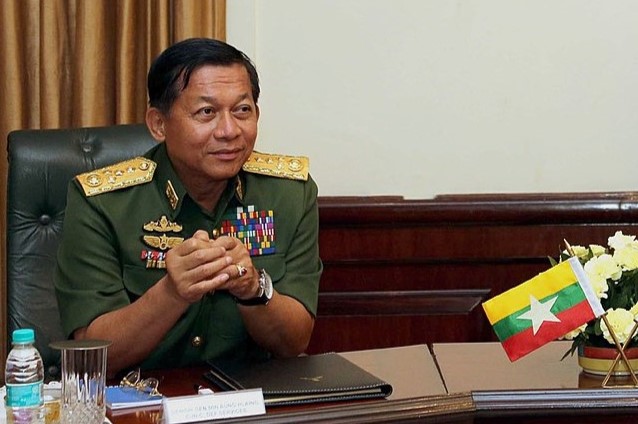 The Min Aung Hlaing junta has also lost control of the economic situation / Image: Ministry of Defence (GODL-India), Wikimedia Commons
The Min Aung Hlaing junta has also lost control of the economic situation / Image: Ministry of Defence (GODL-India), Wikimedia Commons
This has immediately resulted in shortages of oil and gas, with skyrocketing prices and scenes of long queues. With the further depreciation of the Kyat, price hikes have become generalised for all commodities but one: labour power i.e. wages. We can expect shortages of essential drugs and other important imported goods in the coming months.
At the moment, some garment factories in Yangon industrial zones are being forced to halt due to power outages and a lack of diesel. Starvation and unemployment will become intolerable for the working class.
Deep economic crisis and civil war are constantly undermining the very foundations of the military regime. They have reached a blind alley and can find no way out. These objective conditions are exactly the combustible materials that could break out into a blaze sooner or later.
The role of the liberals and perspectives for the regime
The course of the civil war is inspiring renewed confidence and bravery among the masses in the cities. While no mass movement has yet materialised, the junta regime (or at least a section within it) must see that this is a real perspective in the near future should they continue to lose ground. If they lack such foresight, then the Chinese regime certainly does not.
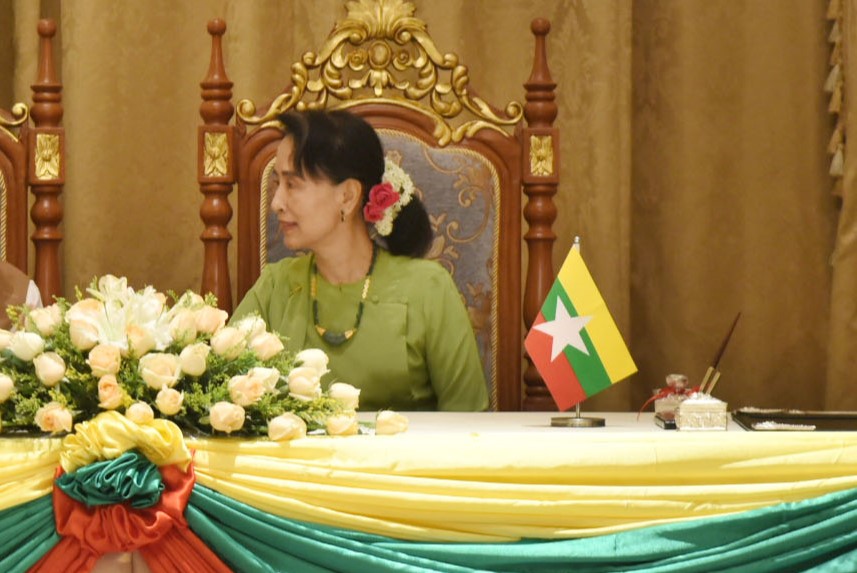 We cannot rule out that renewed hope may spring among the masses for the liberals, with Aung San Suu Kyi (ASSK) at their head / Image: Prime Minister's Office (GODL-India), Wikimedia Commons
We cannot rule out that renewed hope may spring among the masses for the liberals, with Aung San Suu Kyi (ASSK) at their head / Image: Prime Minister's Office (GODL-India), Wikimedia Commons
With the Min Aung Hliang clique currently remaining entrenched, we cannot rule out that renewed hope may spring among the masses for the liberals, with Aung San Suu Kyi (ASSK) at their head. They could regain a certain base of support.
Yet the liberals, who operate the so-called National Unity Government (NUG), have fundamentally the same bourgeois class interests as the junta, even down to agreement on Myanmar’s alignment with Chinese imperialism. Their primary difference lies in the Junta’s narrow fear of losing its privileges and potentially seeing its members prosecuted for their crimes against the masses, even though ASSK herself has co-governed the country with the Junta in the past.
Given the revolutionary fervour that is brewing in the context of recent events, the top leaders at the very least, like Min Aung Hlaing, can be expected to remain stubborn. However, there could be other layers in the military who would be willing to work with the liberals in co-governing the country again.
Marxists however must maintain that for the workers and youth of Myanmar, the liberals are no alternative. By their very nature, the bourgeoisie that the liberals represent are a supine and ineffective opposition to the military strongmen. They fear the working class far more than the Junta. When called upon, they can be no less brutal than the military.
We can see this in action. Currently, the so-called NUG is attempting to act like a real government on the ground. When the ethnic rebel forces seized town after town, their People’s Defence Forces (PDFs) needed to demonstrate their strength. This compelled them to seize a district town in the Sagaing region. As in the other towns under the control of resistance forces, local residents were forced to flee their homes.
Yet, no one would say that this district town is of such strategic significance that it must be seized at any price. As a consequence, The Irrawaddy claims that “Sagaing Region has reported the most deaths. Thirty-two civilians were killed and 50 injured in Sagaing Region by junta airstrikes” since November 2023.
Should the NUG somehow return to the government, likely in collaboration with a section of the Junta, they may well be forced to concede certain democratic rights to bolster the illusions of the masses. But the brutality of the Junta regime is based on the acute contradictions in Burmese society. As soon as the honeymoon period of a new government is exhausted – which under the pressure of these contradictions would not take long – it would in turn be forced to turn to the same methods of repression and clamp downs.
The working class: a decisive element
These offensives by the resistance forces have dealt a very hard blow to the ruling military regime. The ruling clique fears its imminent demise. But, the decisive element is not yet on the scene.
The surrender of the Junta’s light infantry battalions shows the fault lines in the rotten military, and the possibility of a genuine revolutionary movement cracking it.
But with most so-called ‘revolutionaries’ expending their energies on the armed struggle, no effort is being put into building a revolutionary mass party on the lines of the Bolshevik Party. Therefore, when the working-class masses rise up, it will take on a spontaneous character that will take these ‘revolutionaries’ by surprise. This is precisely what happened during the rising against the coup regime in 2021, when the absence of revolutionary leadership allowed the liberals to come to the fore. The danger would be a repetition along these lines.
As Trotsky brilliantly explained in his preface to The History of the Russian Revolution:
“The masses go into a revolution not with a prepared plan of social reconstruction, but with a sharp feeling that they cannot endure the old regime. Only the guiding layers of a class have a political program, and even this still requires the test of events, and the approval of the masses. The fundamental political process of the revolution thus consists in the gradual comprehension by a class of the problems arising from the social crisis—the active orientation of the masses by a method of successive approximations.”
“Without a guiding organisation, the energy of the masses would dissipate like steam not enclosed in a piston box. But nevertheless what moves things is not the piston or the box, but the steam.”
The process of successive approximation on the part of the Burmese proletariat is now taking a further step. The liberals and their supporters, however, will do all they can to ensure that the masses draw the wrong conclusions. Revolutionary communists will continue to advance the correct views that alone can help the working class clearly see its historical role of leading the socialist revolution, and seizing power into its own hands so as to liberate itself and the oppressed masses from endless barbaric crises of capitalism. To achieve that requires the building of a strong revolutionary cadre organisation – is the most important and urgent task of the present.
